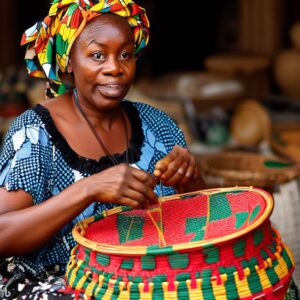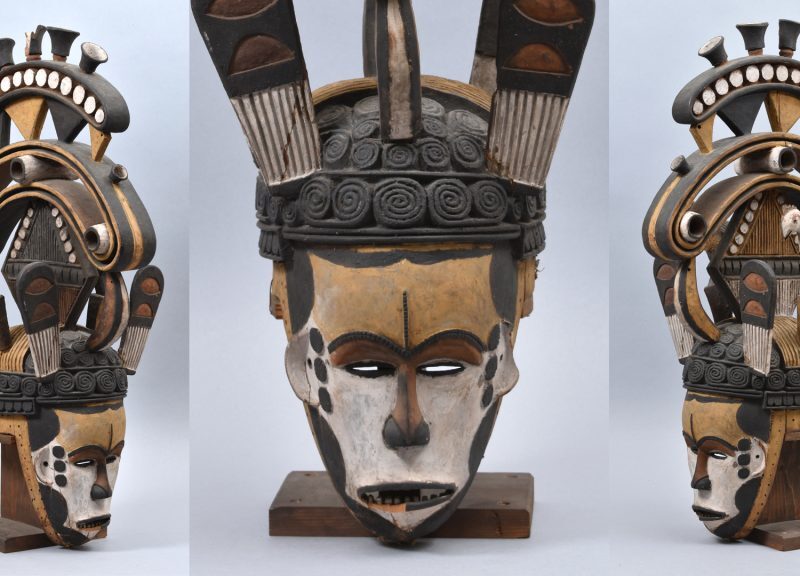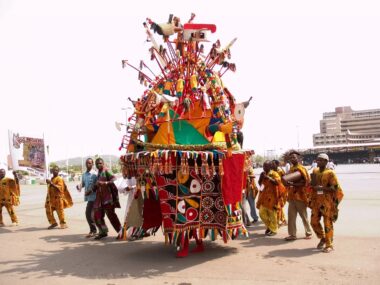Nigeria, a country rich in cultural diversity and history, is renowned for its vibrant art and craft traditions. The role of art and craft in Nigerian cultural preservation is multifaceted, encompassing the transmission of cultural values, historical continuity, and the promotion of national identity. This essay explores the various dimensions through which art and craft contribute to the preservation of Nigerian culture.

Historical Context and Diversity of Nigerian Art and Craft
Nigeria’s art and craft traditions date back thousands of years, with evidence of sophisticated artistic expressions found in archaeological sites such as Nok, Ife, and Benin. Each ethnic group in Nigeria, of which there are over 250, has its unique art forms that reflect its history, beliefs, and social structures. The diversity of Nigerian art is a testament to the country’s rich cultural tapestry.
For instance, the Nok culture, which flourished between 1500 BCE and 500 CE, is known for its terracotta sculptures depicting human and animal figures. These artifacts provide insights into the early artistic practices and social life of the Nok people. Similarly, the Ife culture, which peaked between the 12th and 15th centuries, produced bronze and terracotta sculptures that are celebrated for their realism and intricate details. The Benin Kingdom, known for its bronze plaques and sculptures, also highlights the sophistication of Nigerian art.
Transmission of Cultural Values
Art and craft in Nigeria serve as vehicles for transmitting cultural values and knowledge from one generation to the next. Traditional art forms often embody the philosophical and moral principles of the community. For example, Yoruba carvings and masks are not merely decorative but are imbued with spiritual and ethical meanings. These artifacts are used in rituals, ceremonies, and festivals, thereby reinforcing communal values and beliefs.
The storytelling aspect of Nigerian art is also significant. Many traditional crafts, such as the Igbo Uli body and wall paintings, incorporate symbols and motifs that convey stories, proverbs, and historical events. These visual narratives play a crucial role in educating younger generations about their heritage and instilling a sense of pride and identity.
Economic and Social Significance
Beyond their cultural and historical importance, Nigerian art and craft have significant economic and social roles. The craft industry provides livelihoods for many artisans and their families, contributing to the local and national economy. Markets and fairs, where these crafts are sold, also serve as cultural hubs where people can engage with their heritage.
In recent years, there has been a growing recognition of the potential for Nigerian art and craft to drive sustainable development. Initiatives to promote traditional crafts, such as weaving, pottery, and beadwork, not only help preserve these art forms but also create economic opportunities for artisans. Furthermore, the international appeal of Nigerian art has led to its presence in global art markets, enhancing cultural exchange and understanding.
Art and Craft in Modern Nigerian Society
While traditional art forms continue to be celebrated, contemporary Nigerian artists are also playing a crucial role in cultural preservation. Modern artists often draw inspiration from traditional themes and techniques, blending them with contemporary styles and mediums. This fusion creates a dynamic and evolving art scene that remains rooted in cultural heritage.
Organizations and institutions, such as the National Council for Arts and Culture (NCAC) and various cultural festivals, actively promote Nigerian art and craft. Museums and galleries across Nigeria exhibit both traditional and contemporary works, providing platforms for artists to showcase their talents and for the public to engage with their cultural heritage.
Education also plays a vital role in preserving art and craft traditions. Art education programs in schools and universities help nurture young talents and instill an appreciation for cultural heritage. Workshops and training programs for artisans ensure the continuity of traditional skills and techniques.
Challenges and Preservation Efforts
Despite the vibrant art scene, Nigerian art and craft face several challenges. The commercialization of cultural artifacts, loss of traditional skills, and the impact of globalization pose threats to the preservation of these art forms. Additionally, inadequate funding and support for the arts sector hinder the efforts of many artists and cultural institutions.
However, various initiatives are underway to address these challenges. Government policies aimed at promoting cultural heritage, along with support from non-governmental organizations and the private sector, are crucial in sustaining the art and craft traditions. Digital platforms and social media also offer new avenues for artists to reach wider audiences and for the documentation and dissemination of cultural knowledge.
Conclusion
The role of art and craft in Nigerian cultural preservation is profound and multifaceted. Through the transmission of cultural values, economic contributions, and the engagement of contemporary and traditional practices, art and craft serve as vital components of Nigeria’s cultural identity. As Nigeria continues to navigate the complexities of modernization and globalization, the preservation of its rich artistic heritage remains essential. By supporting and promoting Nigerian art and craft, the nation can ensure that its cultural legacy endures for future generations.










